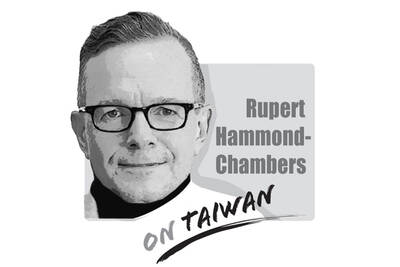Last week, Vice President Hsiao Bi-khim (蕭美琴) posted on the social media platform X a screenshot of her virtual call with US Senator Bill Hagerty, accompanied by a caption that read, “I’ve always appreciated his [Hagerty’s] support for the Taiwan-US partnership.”
There was no mention of the content of their call, but some have speculated that it might have been related to the final phase of tariff negotiations. Taiwan and the US are lacking the finishing touches to reach an agreement, and the government likely hopes it can rely on Hagerty to urge US President Donald Trump to finalize the decision as soon as possible.
Hagerty, a former private equity executive, joined the first Trump administration’s transition team in 2016. First appointed by Trump in 2017 to be the 30th US ambassador to Japan, he was eventually elected as a US senator representing the state of Tennessee in 2021. He has been a consistent and prominent advocate of Trump’s Make America Great Again (MAGA) movement, and is regarded as one of the key figures close to Trump’s inner decisionmaking circle.
Former Trump national security adviser Lieutenant General H.R. McMaster praised Hagerty for combining an entrepreneurial business mindset with practical experience in diplomacy, particularly his deep understanding of US congressional negotiations and coordination. Hagerty retains traits of a moderate Republican and was once considered a strong contender for a Cabinet position in Trump’s second term. Rumors linked him to roles ranging from US secretary of state to secretary of the treasury. However, Hagerty ultimately remained in the US Senate, where he serves as Trump’s eyes and ears.
A frequent guest on conservative media such as Fox News and Newsmax, Hagerty has promoted and defended MAGA policies, boosting his position in the eyes of Trump’s base. Hagerty has given several interviews this month covering topics such as Trump’s pressure on Russia and Chinese President Xi Jinping’s (習近平) authoritarian alliance with Iran, North Korea and Russia.
As a member of the US Senate Committee on Foreign Relations, Hagerty’s statements are widely regarded as carrying significant authority.
Last month, Indian Ambassador to the US Vinay Mohan Kwatra met with Hagerty, later thanking him online for his “consistent and strong support to the India-US partnership.” The US-India relationship has hit an unprecedented low due to tensions over India’s purchase of Russian oil. The Trump administration has imposed tariffs of up to 50 percent on India, the highest of anywhere else in the world. Despite this, Hagerty is still viewed by New Delhi as one of the most effective channels for communication with the White House.
On Thursday last week, the US Senate held a confirmation hearing for the new nominee for US ambassador to India, White House Presidential Personnel Office Director Sergio Gor. In his introduction of Gor, Hagarty said that few relationships are as critically important to defense, trade and regional stability as the one between the US and India. News of warming ties between the two countries quickly began to spread following the hearing.
After leveraging the extensive network he cultivated during three and a half years as US ambassador to Japan, Hagerty would certainly not be Hsiao’s only point of contact for high-level virtual consultations. He has played a key role in advancing Taiwan-US trade negotiations in their final phase, working to overcome the delays and constraints linked to US-China tariff negotiations. As US Secretary of Commerce Howard Lutnick said, a “big deal” is now on the horizon.
Chen Yung-chang is a freelance writer based in Taipei.
Translated by Kyra Gustavsen

In the past month, two important developments are poised to equip Taiwan with expanded capabilities to play foreign policy offense in an age where Taiwan’s diplomatic space is seriously constricted by a hegemonic Beijing. Taiwan Foreign Minister Lin Chia-lung (林佳龍) led a delegation of Taiwan and US companies to the Philippines to promote trilateral economic cooperation between the three countries. Additionally, in the past two weeks, Taiwan has placed chip export controls on South Africa in an escalating standoff over the placing of its diplomatic mission in Pretoria, causing the South Africans to pause and ask for consultations to resolve
An altercation involving a 73-year-old woman and a younger person broke out on a Taipei MRT train last week, with videos of the incident going viral online, sparking wide discussions about the controversial priority seats and social norms. In the video, the elderly woman, surnamed Tseng (曾), approached a passenger in a priority seat and demanded that she get up, and after she refused, she swung her bag, hitting her on the knees and calves several times. In return, the commuter asked a nearby passenger to hold her bag, stood up and kicked Tseng, causing her to fall backward and
In December 1937, Japanese troops captured Nanjing and unleashed one of the darkest chapters of the 20th century. Over six weeks, hundreds of thousands were slaughtered and women were raped on a scale that still defies comprehension. Across Asia, the Japanese occupation left deep scars. Singapore, Malaya, the Philippines and much of China endured terror, forced labor and massacres. My own grandfather was tortured by the Japanese in Singapore. His wife, traumatized beyond recovery, lived the rest of her life in silence and breakdown. These stories are real, not abstract history. Here is the irony: Mao Zedong (毛澤東) himself once told visiting
When I reminded my 83-year-old mother on Wednesday that it was the 76th anniversary of the founding of the People’s Republic of China, she replied: “Yes, it was the day when my family was broken.” That answer captures the paradox of modern China. To most Chinese in mainland China, Oct. 1 is a day of pride — a celebration of national strength, prosperity and global stature. However, on a deeper level, it is also a reminder to many of the families shattered, the freedoms extinguished and the lives sacrificed on the road here. Seventy-six years ago, Chinese Communist leader Mao Zedong (毛澤東)